The Relationship of Soil Organic Carbon and Nutrient Contents to Maize Yield as Affected by Maize Straw Return Modes
Abstract
:1. Introduction
2. Materials and Methods
2.1. Field Trial Site and Design
2.2. Soil Sampling and Analysis
2.3. Statistical Analysis
3. Results and Discussion
3.1. Maize Grain Yield and Yield Components
3.2. SOC and Nutrient Contents
3.3. Relationships between Maize Straw Return Modes, Soil Depths, SOC and Nutrient Contents, and Maize Yield
Author Contributions
Funding
Institutional Review Board Statement
Informed Consent Statement
Data Availability Statement
Conflicts of Interest
References
- Turmel, M.-S.; Speratti, A.; Baudron, F.; Verhulst, N.; Govaerts, B. Crop residue management and soil health: A systems analysis. Agric. Syst. 2015, 134, 6–16. [Google Scholar] [CrossRef]
- Islam, M.U.; Jiang, F.; Halder, M.; Liu, S.; Peng, X. Impact of straw return combined with different fertilizations on soil organic carbon stock in upland wheat and maize croplands in China: A meta-analysis. Crop Environ. 2023. [Google Scholar] [CrossRef]
- Zhang, X.; Wang, J.; Feng, X.; Yang, H.; Li, Y.; Yakov, K.; Liu, S.; Li, F. Effects of tillage on soil organic carbon and crop yield under straw return. Agric. Ecosyst. Environ. 2023, 354, 108543. [Google Scholar] [CrossRef]
- Liu, D.; Song, C.; Xin, Z.; Fang, C.; Liu, Z.; Xu, Y. Agricultural management strategies for balancing yield increase, carbon sequestration, and emission reduction after straw return for three major grain crops in China: A meta-analysis. J. Environ. Manag. 2023, 340, 117965. [Google Scholar] [CrossRef]
- Wang, Y.; Wu, P.; Mei, F.; Ling, Y.; Qiao, Y.; Liu, C.; Leghari, S.J.; Guan, X.; Wang, T. Does continuous straw returning keep China farmland soil organic carbon continued increase? A meta-analysis. J. Environ. Manag. 2021, 288, 112391. [Google Scholar] [CrossRef]
- Huang, T.; Yang, N.; Lu, C.; Qin, X.; Siddique, K.H.M. Soil organic carbon, total nitrogen, available nutrients, and yield under different straw returning methods. Soil Tillage Res. 2021, 214, 105171. [Google Scholar] [CrossRef]
- Liu, X.; Lee Burras, C.; Kravchenko, Y.S.; Duran, A.; Huffman, T.; Morras, H.; Studdert, G.; Zhang, X.; Cruse, R.M.; Yuan, X. Overview of Mollisols in the world: Distribution, land use and management. Can. J. Soil Sci. 2012, 92, 383–402. [Google Scholar] [CrossRef]
- Li, H.; Wang, Y.; Qin, L.; He, H.; Zhang, T.; Wang, J.; Zheng, X. Effects of different slopes and fertilizer types on the grey water footprint of maize production in the black soil region of China. J. Clean. Prod. 2020, 246, 119077. [Google Scholar] [CrossRef]
- Liu, X.; Zhang, X.; Wang, Y.; Sui, Y.; Zhang, S.; Herbert, S.; Ding, G.J.P. Soil; Environment, Soil degradation: A problem threatening the sustainable development of agriculture in Northeast China. Plant Soil Environ. 2010, 56, 87–97. [Google Scholar] [CrossRef]
- Wang, Y.; Gao, S.; Li, C.; Zhang, J.; Wang, L. Effects of temperature on soil organic carbon fractions contents, aggregate stability and structural characteristics of humic substances in a Mollisol. J. Soil Sediment 2016, 16, 1849–1857. [Google Scholar] [CrossRef]
- Feng, Z.; Zheng, F.; Hu, W.; Li, G.; Xu, X. Impacts of mollic epipedon thickness and overloaded sediment deposition on corn yield in the Chinese Mollisol region. Agric. Ecosyst. Environ. 2018, 257, 175–182. [Google Scholar] [CrossRef]
- Xu, X.; Zheng, F.; Wilson, G.V.; He, C.; Lu, J.; Bian, F. Comparison of runoff and soil loss in different tillage systems in the Mollisol region of Northeast China. Soil Tillage Res. 2018, 177, 1–11. [Google Scholar] [CrossRef]
- Cai, L.; Guo, Z.; Zhang, J.; Gai, Z.; Liu, J.; Meng, Q.; Liu, X. No tillage and residue mulching method on bacterial community diversity regulation in a black soil region of Northeastern China. PLoS ONE 2021, 16, e0256970. [Google Scholar] [CrossRef]
- Cai, H.; Liang, Y.; Liu, H.; Liu, J.; Qin, Y.; Liu, F.; Yan, J.; Zhang, H.; Ren, J.; Wang, L. Research on full maize straw returning with deep ploughing mode in the Northeast China. J. Maize Sci. 2019, 27, 123–129. [Google Scholar]
- Liu, G.; Bai, Z.; Shah, F.; Cui, G.; Xio, Z.; Gong, H.; Li, D.; Lin, Y.; Li, B.; Ji, G.; et al. Compositional and structural changes in soil microbial communities in response to straw mulching and plant revegetation in an abandoned artificial pasture in Northeast China. Glob. Ecol. Conserv. 2021, 31, e01871. [Google Scholar] [CrossRef]
- Tian, P.; Sui, P.; Lian, H.; Wang, Z.; Meng, G.; Sun, Y.; Wang, Y.; Su, Y.; Ma, Z.; Qi, H.; et al. Maize straw returning approaches affected straw decomposition and soil carbon and nitrogen storage in Northeast China. Agronomy 2019, 9, 818. [Google Scholar] [CrossRef]
- Lu, R. Analytical Methods for Soil Agricultural Chemistry; China Agricultural Science and Technology Press: Beijing, China, 2000. [Google Scholar]
- Yang, H.; Wu, G.; Mo, P.; Chen, S.; Wang, S.; Xiao, Y.; Ma, H.; Wen, T.; Guo, X.; Fan, G. The combined effects of maize straw mulch and no-tillage on grain yield and water and nitrogen use efficiency of dry-land winter wheat (Triticum aestivum L.). Soil Tillage Res. 2020, 197, 104485. [Google Scholar] [CrossRef]
- Gao, Y.; Xie, Y.; Jiang, H.; Wu, B.; Niu, J. Soil water status and root distribution across the rooting zone in maize with plastic film mulching. Field Crop Res. 2014, 156, 40–47. [Google Scholar] [CrossRef]
- Ibrahim, M.; Yamin, M.; Sarwar, G.; Anayat, A.; Habib, F.; Ullah, S.; Saifur, R. Tillage and farm manure affect root growth and nutrient uptake of wheat and rice under semi-arid conditions. Appl. Geochem. 2011, 26, S194–S197. [Google Scholar] [CrossRef]
- Yang, H.; Zhou, J.; Feng, J.; Zhai, S.; Chen, W.; Liu, J.; Bian, X. Chapter Five-Ditch-buried straw return: A novel tillage practice combined with tillage rotation and deep ploughing in rice-wheat rotation systems. In Advances in Agronomy; Sparks, D.L., Ed.; Academic Press: Cambridge, MA, USA, 2019; Volume 154, pp. 257–290. [Google Scholar]
- Wang, H.; Wang, S.; Zhang, Y.; Wang, X.; Wang, R.; Li, J. Tillage system change affects soil organic carbon storage and benefits land restoration on loess soil in North China. Land Degrad. Dev. 2018, 29, 2880–2887. [Google Scholar] [CrossRef]
- Cong, P.; Wang, J.; Li, Y.; Liu, N.; Dong, J.; Pang, H.; Zhang, L.; Gao, Z. Changes in soil organic carbon and microbial community under varying straw incorporation strategies. Soil Tillage Res. 2020, 204, 104735. [Google Scholar] [CrossRef]
- Ndzelu, B.S.; Dou, S.; Zhang, X. Corn straw return can increase labile soil organic carbon fractions and improve water-stable aggregates in Haplic Cambisol. J. Arid Land 2020, 12, 1018–1030. [Google Scholar] [CrossRef]
- Zhang, J.; Du, L.; Xing, Z.; Zhang, R.; Li, F.; Zhong, T.; Ren, F.; Yin, M.; Ding, L.; Liu, X. Effects of dual mulching with wheat straw and plastic film under three irrigation regimes on soil nutrients and growth of edible sunflower. Agric. Water Manag. 2023, 288, 108453. [Google Scholar] [CrossRef]
- Si, P.; Liu, E.; He, W.; Sun, Z.; Dong, W.; Yan, C.; Zhang, Y. Effect of no-tillage with straw mulch and conventional tillage on soil organic carbon pools in Northern China. Arch. Agron. Soil Sci. 2017, 64, 398–408. [Google Scholar] [CrossRef]
- Fu, X.; Wang, J.; Sainju, U.M.; Liu, W. Aggregate size distribution and associated carbon and nitrogen in mulched winter wheat and spring corn. Can. J. Soil Sci. 2019, 99, 367–379. [Google Scholar] [CrossRef]
- Zheng, S.; Dou, S.; Duan, H.; Zhang, B.; Bai, Y. Fluorescence spectroscopy and 13C NMR spectroscopy characteristics of HA in black soil at different corn straw returning modes. Int. J. Anal. Chem. 2021, 2021, 9940116. [Google Scholar] [CrossRef]
- Ling, J.; Zhou, J.; Wu, G.; Zhao, D.; Wang, Z.; Wen, Y.; Zhou, S. Deep-injected straw incorporation enhances subsoil quality and wheat productivity. Plant Soil 2022, 1–14. [Google Scholar] [CrossRef]
- Yang, X.; Li, Z.; Cheng, C. Effect of conservation tillage practices on soil phosphorus nutrition in an apple orchard. Hortic. Plant J. 2016, 2, 331–337. [Google Scholar] [CrossRef]
- Tian, P.; Lian, H.; Wang, Z.; Jiang, Y.; Li, C.; Sui, P.; Qi, H. Effects of deep and shallow tillage with straw incorporation on soil organic carbon, total nitrogen and enzyme activities in Northeast China. Sustainability 2020, 12, 8679. [Google Scholar] [CrossRef]
- He, T.; Yang, Y.; Peng, T.; Wang, Y.; Zhang, G.; Chen, X.; Liu, Y.; Liu, B. The role of straw mulching in shaping rills and stabilizing rill network under simulated extreme rainfall. Soil Tillage Res. 2023, 229, 105656. [Google Scholar] [CrossRef]
- Alcantara, V.; Don, A.; Well, R.; Nieder, R. Deep ploughing increases agricultural soil organic matter stocks. Glob. Chang. Biol. 2016, 22, 2939–2956. [Google Scholar] [CrossRef] [PubMed]
- Zhang, J.; Jia, L.; Zhang, Z.; Wei, Y.; Wang, Y.; Su, Z. Effect of the soil-implement contact area on soil translocation under hoeing tillage. Soil Tillage Res. 2018, 183, 42–50. [Google Scholar] [CrossRef]

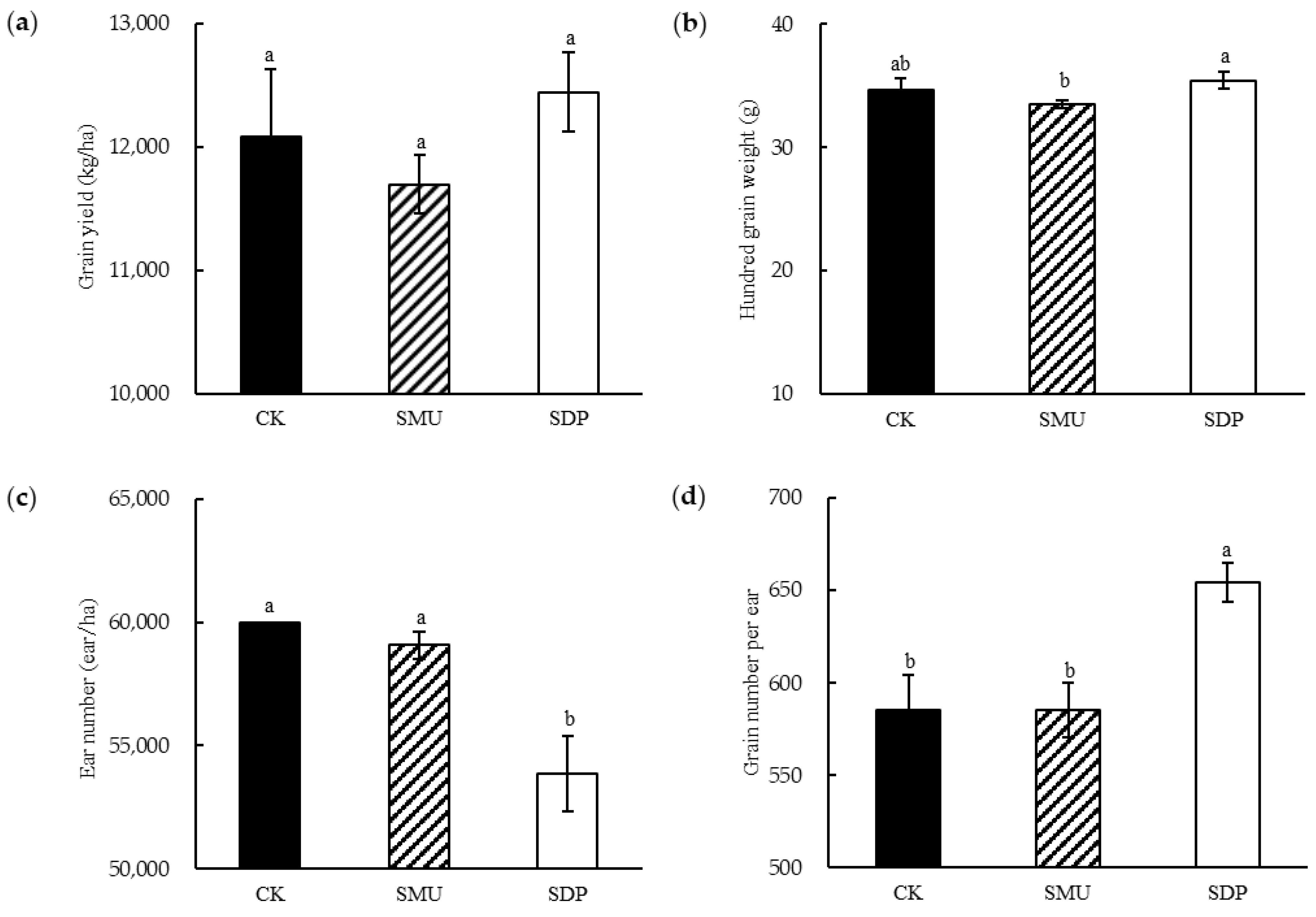
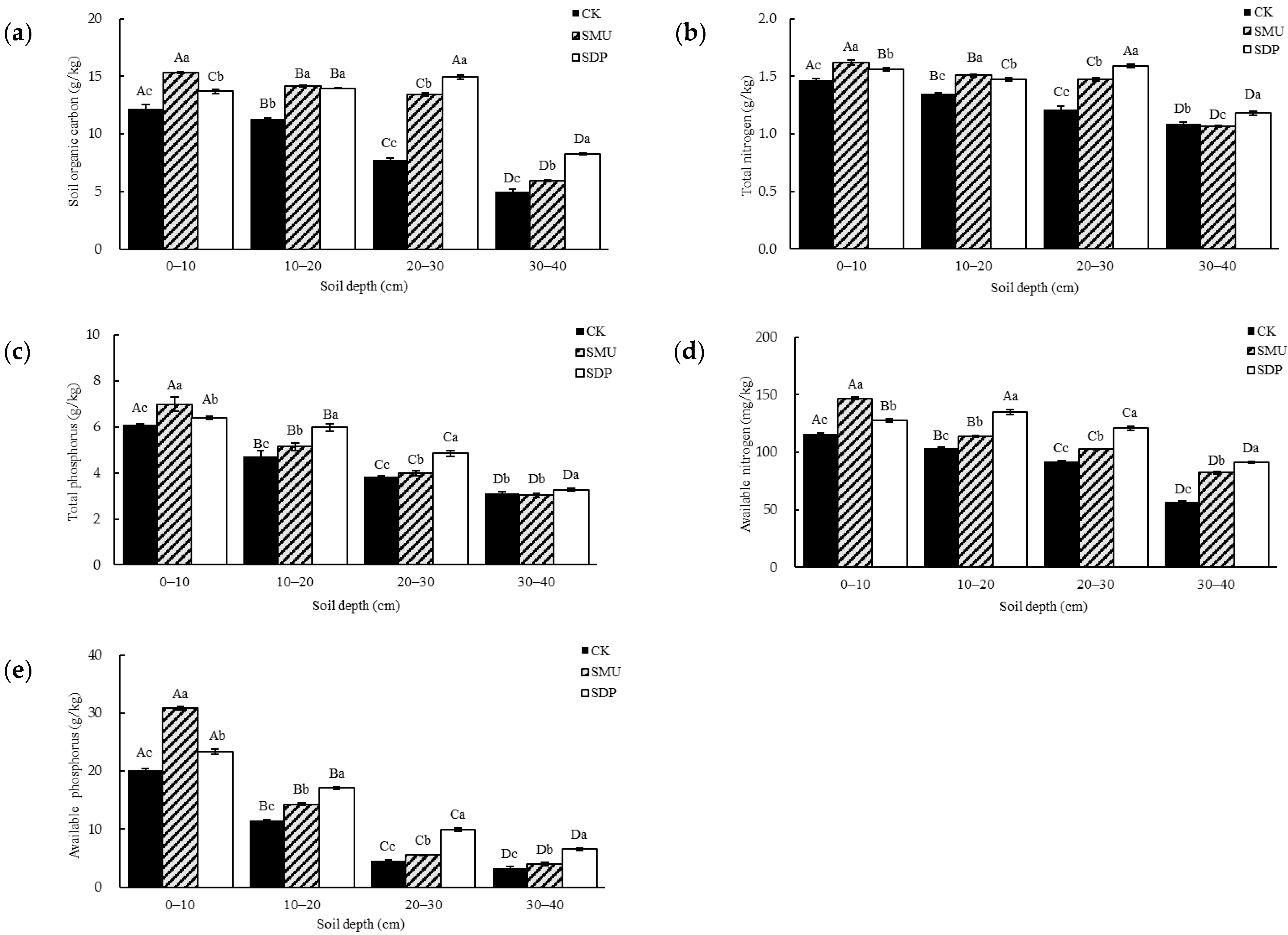
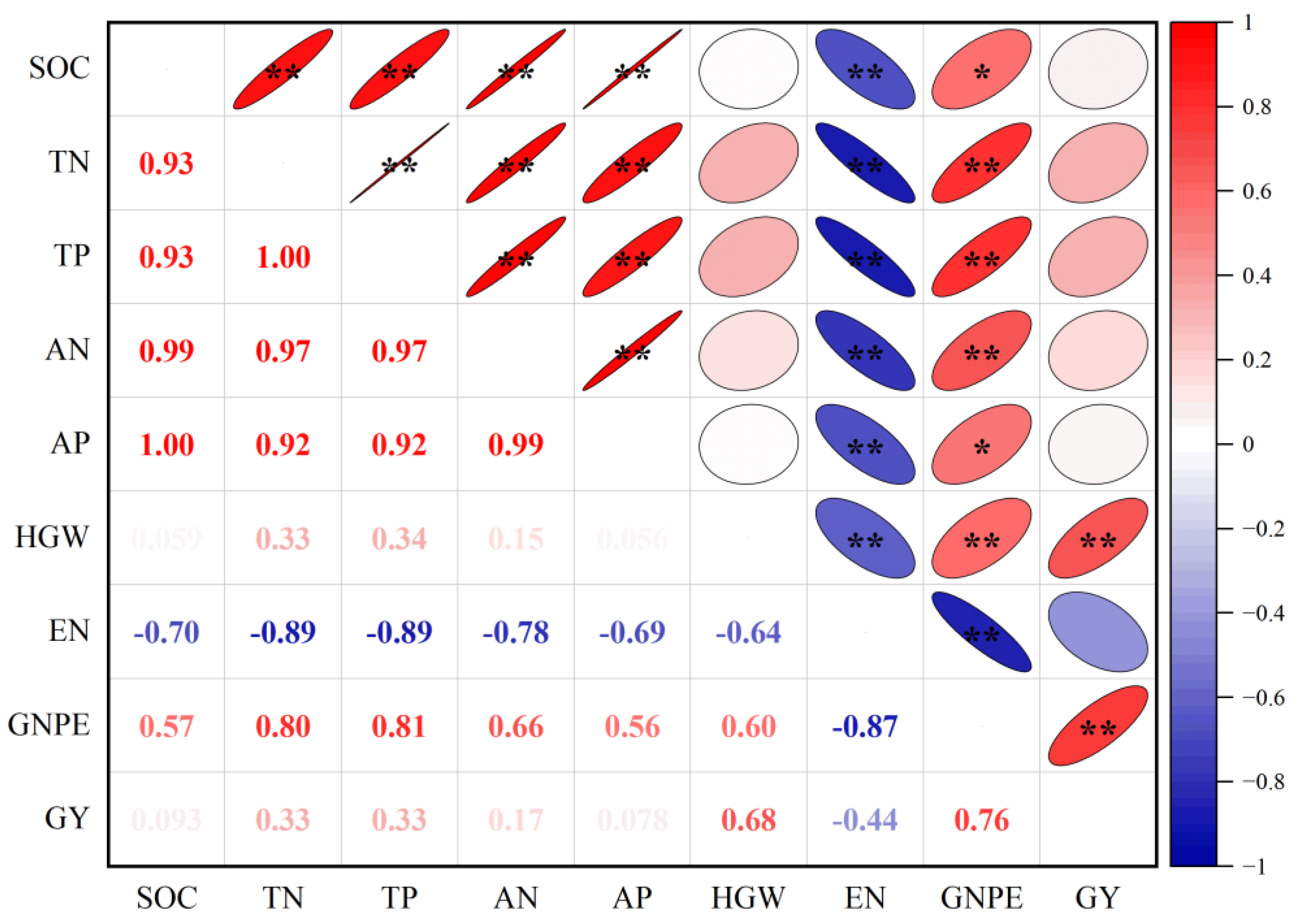
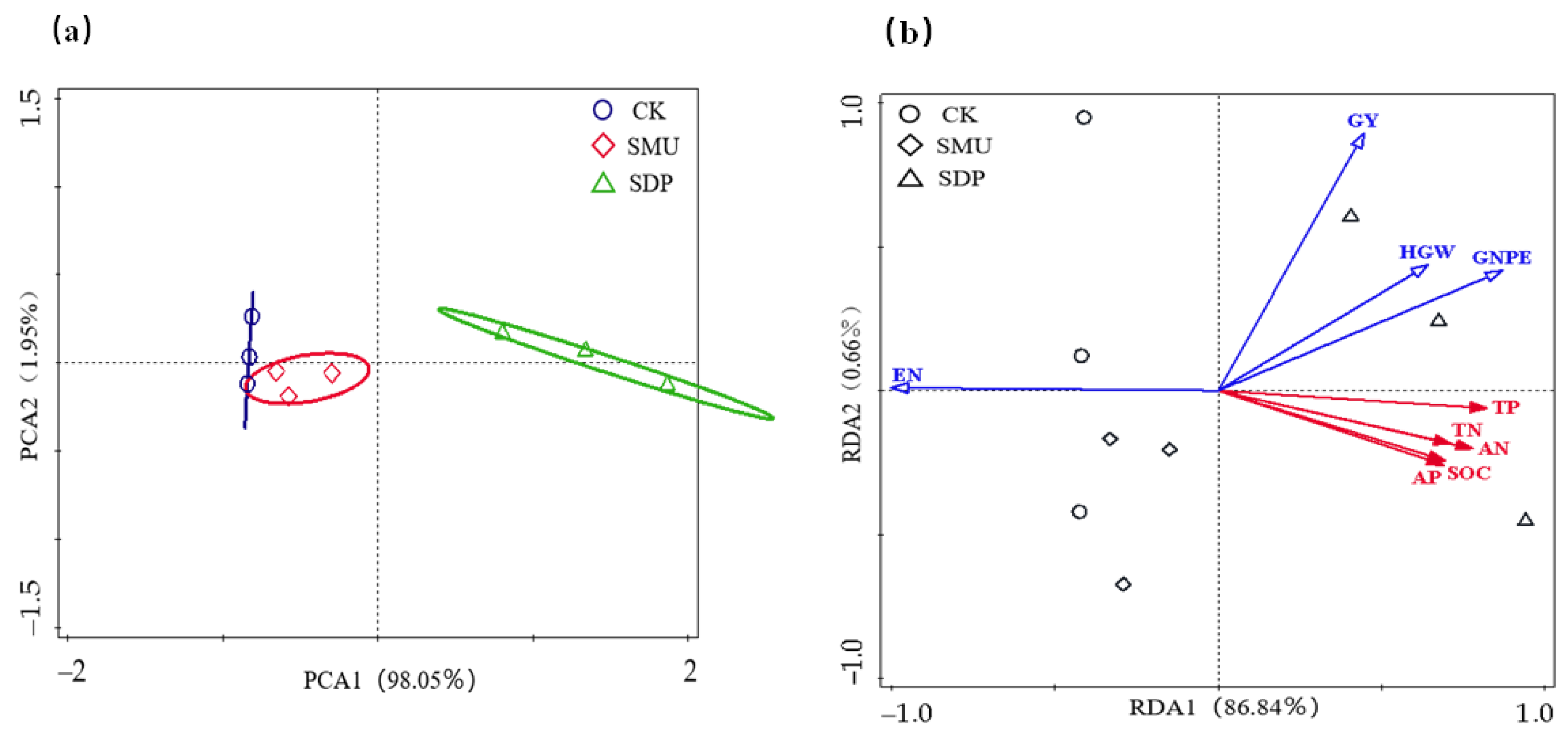
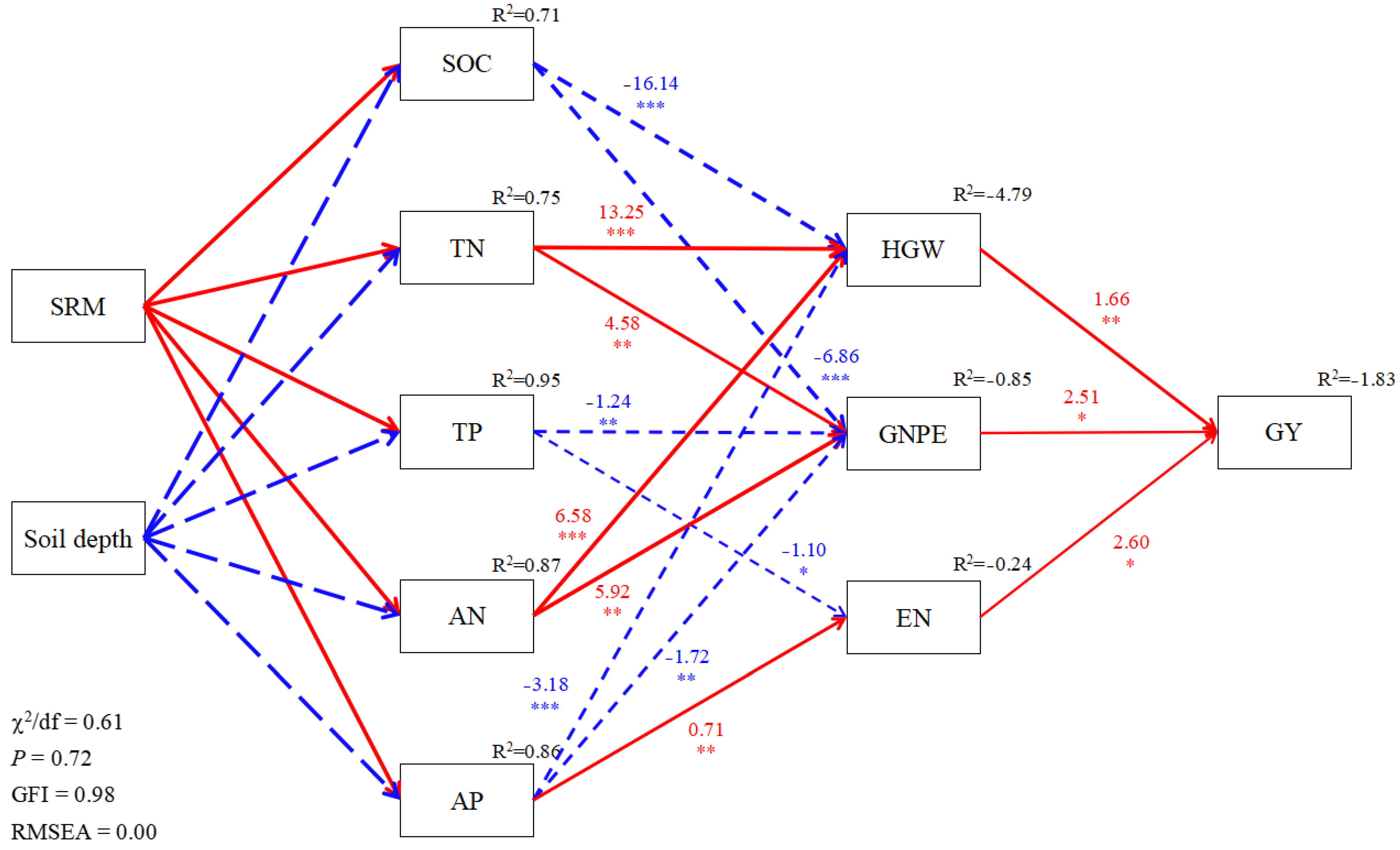
| Soil Depth (cm) | pH | SOC (g/kg) | Total N (g/kg) | Total P (g/kg) | Total K (g/kg) | Available N (mg/kg) | Available P (mg/kg) | Available K (mg/kg) |
|---|---|---|---|---|---|---|---|---|
| 0–20 | 5.39 | 9.56 | 0.81 | 0.24 | 11.3 | 193.1 | 20.4 | 144.1 |
| 20–40 | 5.73 | 9.41 | 0.76 | 0.20 | 10.9 | 147.5 | 17.9 | 153.8 |
| Source of Variation | d.f. | SOC | Total N | Total P | Available N | Available P | |||||
|---|---|---|---|---|---|---|---|---|---|---|---|
| F | p | F | p | F | p | F | p | F | p | ||
| Return modes (A) | 2 | 1675.1 | <0.01 | 396.3 | <0.01 | 63.2 | <0.01 | 1664.5 | <0.01 | 1020.1 | <0.01 |
| Soil depths (B) | 3 | 3613.8 | <0.01 | 1260.0 | <0.01 | 853.8 | <0.01 | 3437.1 | <0.01 | 11,206.1 | <0.01 |
| A × B | 6 | 232.0 | <0.01 | 83.2 | <0.01 | 21.1 | <0.01 | 201.0 | <0.01 | 395.0 | <0.01 |
| Error | 24 | ||||||||||
Disclaimer/Publisher’s Note: The statements, opinions and data contained in all publications are solely those of the individual author(s) and contributor(s) and not of MDPI and/or the editor(s). MDPI and/or the editor(s) disclaim responsibility for any injury to people or property resulting from any ideas, methods, instructions or products referred to in the content. |
© 2023 by the authors. Licensee MDPI, Basel, Switzerland. This article is an open access article distributed under the terms and conditions of the Creative Commons Attribution (CC BY) license (https://creativecommons.org/licenses/by/4.0/).
Share and Cite
Wang, C.; Liang, Y.; Liu, J.; Yuan, J.; Ren, J.; Geng, Y.; Shao, Z.; Zhang, J.; Cai, H. The Relationship of Soil Organic Carbon and Nutrient Contents to Maize Yield as Affected by Maize Straw Return Modes. Appl. Sci. 2023, 13, 12448. https://doi.org/10.3390/app132212448
Wang C, Liang Y, Liu J, Yuan J, Ren J, Geng Y, Shao Z, Zhang J, Cai H. The Relationship of Soil Organic Carbon and Nutrient Contents to Maize Yield as Affected by Maize Straw Return Modes. Applied Sciences. 2023; 13(22):12448. https://doi.org/10.3390/app132212448
Chicago/Turabian StyleWang, Chuanyu, Yao Liang, Jianzhao Liu, Jingchao Yuan, Jun Ren, Yidan Geng, Zeqiang Shao, Jinjing Zhang, and Hongguang Cai. 2023. "The Relationship of Soil Organic Carbon and Nutrient Contents to Maize Yield as Affected by Maize Straw Return Modes" Applied Sciences 13, no. 22: 12448. https://doi.org/10.3390/app132212448






